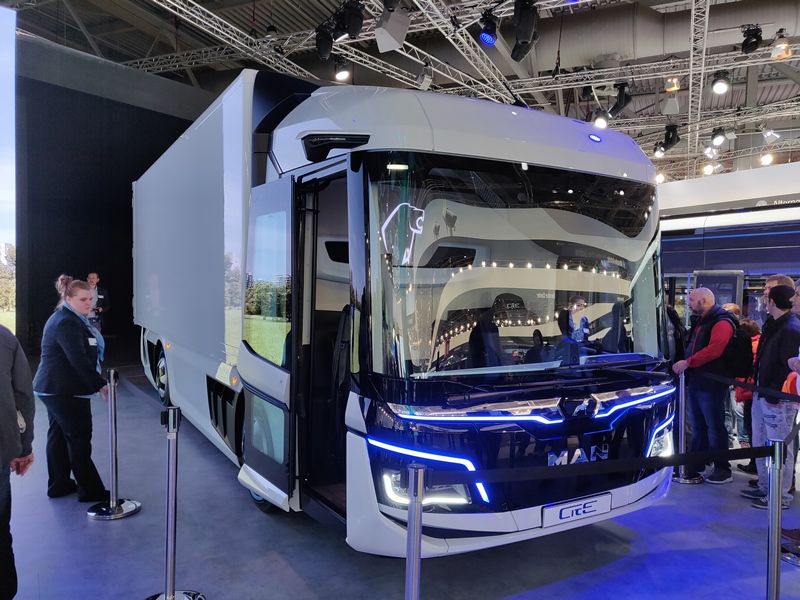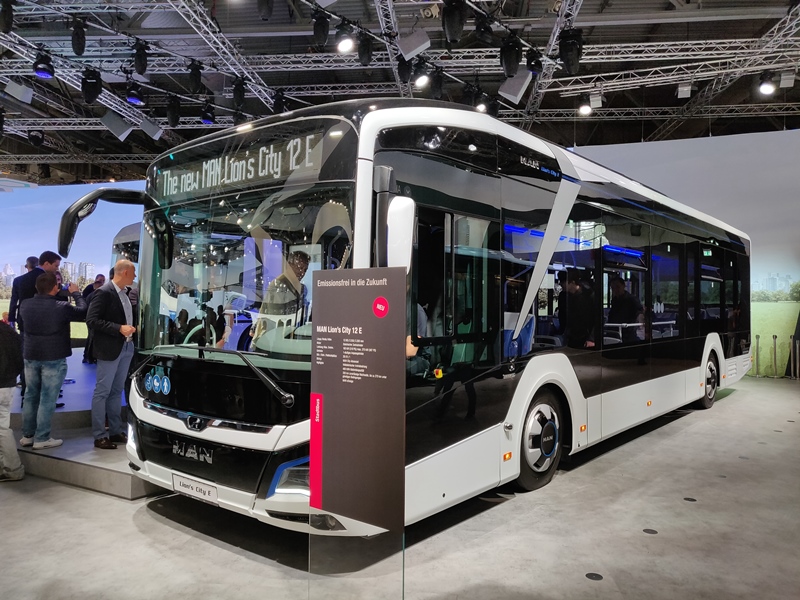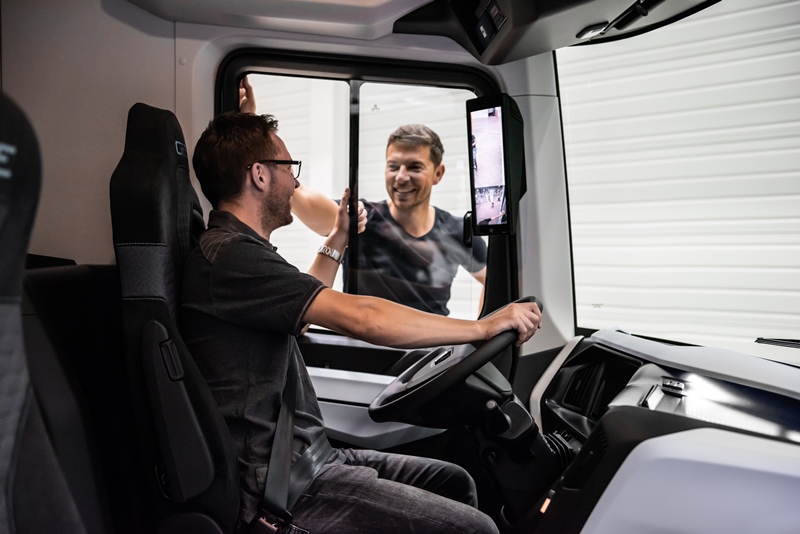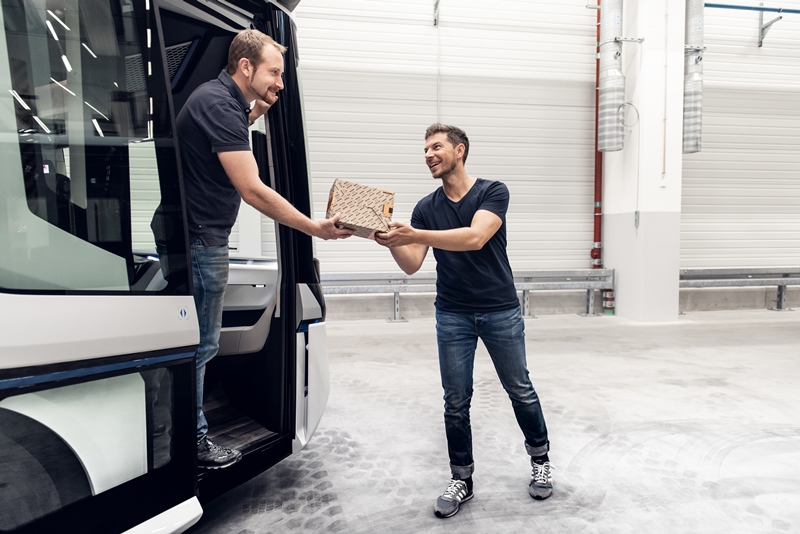At the IAA 2018, MAN Truck & Bus presented the MAN CitE that has been designed specifically for city cargo traffic. The 15 ton vehicle is characterised by its ergonomic design with very low access, continuous level driver cab floor and easy accessibility. The low sitting position, generous glass surfaces as well as assisting cameras also provide an all-round safe view of the surrounding traffic situations for the driver and passenger. The new electric truck concept that was created in only 18 months sets the benchmark in work place ergonomics, safety and sustainability in city distribution transport.
With regard to the topics of traffic and life quality, cities face increasing challenges. Until 2050, urban population will increase by 50 percent worldwide. This growth means, in particular, more and more delivery and disposal traffic, noise, congestion and emissions. The result is more strict laws and guidelines. The providers of transport services must adopt their work processes to this and, at the same time, take account of the increasing demand for transport. How will goods be transported to the businesses in the city despite stricter noise and emission restrictions? How can accidents and collision damage be avoided in city traffic that is increasing in density. What can make the daily work of the driver easier when they have to get in and out of their vehicle dozens of times during their tour? With the CitE, MAN presents a distribution vehicle that is an answer to this.
MAN CitE: Focus on ergonomics
The entry on the drivers’ side is particularly easy and comfortable on the 350 mm low step. Thanks to the level drivers cab floor slightly pulled in, the driver can sit on the seat and then swing their legs in. The completely level drivers cab floor provides maximum freedom of movement in the cab. The driver has a free passage to the passenger side. Here, with its large swivel sliding door that is opened electrically, CitE provides especially, when parking in the second row, the best working conditions. It opens over the complete width and height of the doorway. The co-driver’s seat folds up automatically and provides additional space for the passage. In this way, the driver can get in and out standing upright and without effort, without having to hold on to anything. This is an indispensable benefit for many deliver addresses per tour. When opening, the sliding door needs only a little space to the side. This also allows unloading in narrow parking places or when stopping in second lines without any problems.
The CitE is also a master of ergonomics when travelling. All displays around the driver’s workplace are in the direct field of vision. The display has been designed fully digital for the optimum visualisation of all information for the driver. The switches arranged logically according to how frequently they are used are easily reached from a normal sitting position, as well as the cup holder and stowage trays.
The shelves in the immediate vicinity of the driver’s workplace are numerous more. This includes a holder in the middle area, behind which a cool box or a drinks box can be safely stowed. Behind this, on the back wall, the driver has a spacious storage available. On both wheel arches, the driver finds shelves, e.g. for a bag. A cup holder is conveniently located directly on the driver’s seat. Further down, a clipboard with shipping papers can be safely stowed. Above the driver there is also a large roof shelf with an open pulled-around compartment above the door. Another large shelf in the dashboard extends to the passenger side. Shipping documents also find a safe place directly on the dashboard. In the lower part of the door panel is a large bowl integrated, which can also accommodate 2 bottles (up to 1.5 litres of PET bottle). Above the door handle is an additional small open shelf. So that the driver can find his way easily even at night, the cabin is optimally illuminated for work. These include the cabin lighting as well as lighting for the shelves. A universal tablet / smartphone holder in the dashboard is available within the immediate sight and reach of the driver. This makes it possible to integrate a customized tablet or smartphone into the driver’s workstation in such a way that the logistical and goods flow-oriented processes are optimally integrated into the workflow. Detached from the vehicle, the device can be operated in the customer’s own network. USB charging sockets are provided immediately next to the holder. Thus, customer-related functions for the fleet, such as a digital delivery note, are optimally integrated into the workflow.
The air conditioning of the CitE is designed for the particular requirements in city delivery traffic. The driver gets in and out many times per tour and is always on the move. The doors are opened frequently. Heat escapes in winter and cooling requirement increases in summer – this means an undesired loss of energy for an electric vehicle. For this purpose, the air conditioning concept of the MAN CitE applies a reduced cab air conditioning and instead of that, contact heat or ventilation through the driver’s seat. In the summer months, the heat and sweat is transported away by the ventilation, in the winter months, the immediate heat is pleasant through the seat and relieves the musculoskeletal system. When the weather is cold, an additional steering wheel heating warms the drivers hands.
MAN CitE: All-round safety
With a city delivery vehicle, safety means, in particular, unrestricted view over the surrounding traffic and other road users. Direct eye contact with cyclists and pedestrians is particularly important for the driver in order to assess situations correctly, e.g. when making turns. MAN has considered this criterion consequently with the design of the CitE. The very low window surfaces all-round provide the driver with a maximum direct view to the outside. Thanks to the low sitting position, they have a viewing contact with pedestrians or cyclists at eye level. To provide them with a free view over the traffic light systems and signs mounted high, the windscreen field of vision is high on the passenger side. As the view to the front and sides is not only important in dense urban traffic, but also what is happening around the vehicle, the driver in the CitE 18 is also provided with a 360 degree birds-eye view camera system.
A panoramic view from the birds-eye view around the entire vehicle is shown on the large central display of the integrated entertainment and navigation system. Pedestrians or cyclists as well as other obstacles such as parked vehicles, and thus when driving slowly and manoeuvring, are always in the view of the driver. Being an effective measure against accidents that are caused by blind spots, the CitE is also equipped with a new mirror replacement system. In doing so, camera on both sides of the vehicle provide live images on two displays installed in the field of vision of the driver and thus reduce the blind spots. At a glance, the driver can assess the complete situation that would otherwise require a rear-view, wide angle and kerb mirror. Depending on the daylight, the camera technology used permits a high-resolution representation of the surroundings so that the driver has a better view at night and with variable light conditions. Moreover, the limitations are reduced compared with a mirror, e.g. fogging up, dirt or being blinded by the sun. This increases safety additionally and, at the same time, reduces the probability of collision damage and thus repair costs.
MAN CitE: Fully-electric, through the city
MAN has consequently designed the CitE as electrically driven city delivery vehicle. As the diesel drive train with a combustion engine over the front axle is no longer required, this permits the design of a low-floor vehicle with very low floor and maximum freedom of movement for the driver in the cab. The drive of the CitE is taken over by a centrally arranged electric motor from the eMobility module of MAN. The lithium ion batteries are located under the vehicle frame and enable a range of at least 100 kilometres – sufficient for a day tour in city delivery traffic. The chassis is completely cladded which increases safety for other road users additionally. Moreover, this guarantees a better protection of the batteries in event of an accident. The clear goal of the CitE was, despite its individual concept with standard superstructures, that it could still be equipped with conventional constructions. Basically, the CitE can therefore be considered for all superstructure applications typical for city delivery traffic; the main focus however, is the dry freight bodies for the distribution of products and goods to small businesses. The MAN CitE is also equipped with special design tyres from Continental. The tyre study Conti e.MotionPro matched specifically to the layout of the CitE is equipped with a specially manufactured tread and with its distinctive blue stripes on the side wall and blue groove bottom on the tread, fits perfectly to the design of the CitE.
MAN CitE: Impossible made possible!
Being a vehicle concept, the MAN CitE is not only a completely new approach with many innovative ideas that deviate from the conventional vehicles. With its creation, the developers even took completely new paths. As, at the beginning, it looked like the project requirements could not be implemented. A completely newly developed drivable electric truck that is consequently designed for the requirements of city distribution traffic should be developed in less than two years – normally a project that takes five years, from the first sketches to revealing the finished vehicle. It was quickly clear to the development team that this is only possible with innovative approaches of the work organisation. They found the solution in the software development sector, with their comparatively short product development cycles. In doing so, agile work methods were the key to control complicated projects flexibly, keep the bureaucratic effort as low as possible and to build up less flexible rules. A cross-functional team was drafted on this basis that, with the agile scrum method, organised their work flexibly and dynamically. Reviews with project participants at regular intervals accelerated the decision processes significantly. Using this agile approach, the MAN CitE could thus be implemented in a period of only 18 months and finally presented ready to drive at the IAA 2018. This success is the exceptional performance of a highly motivated team that, with the MAN CitE, have set new benchmarks for safety, work place ergonomics and sustainability in city distribution traffic. MAN initially presents the CitE to the public at the IAA 2018. With respective positive response and queries, the production of further vehicles on the basis of the MAN CitE is a possible option.



